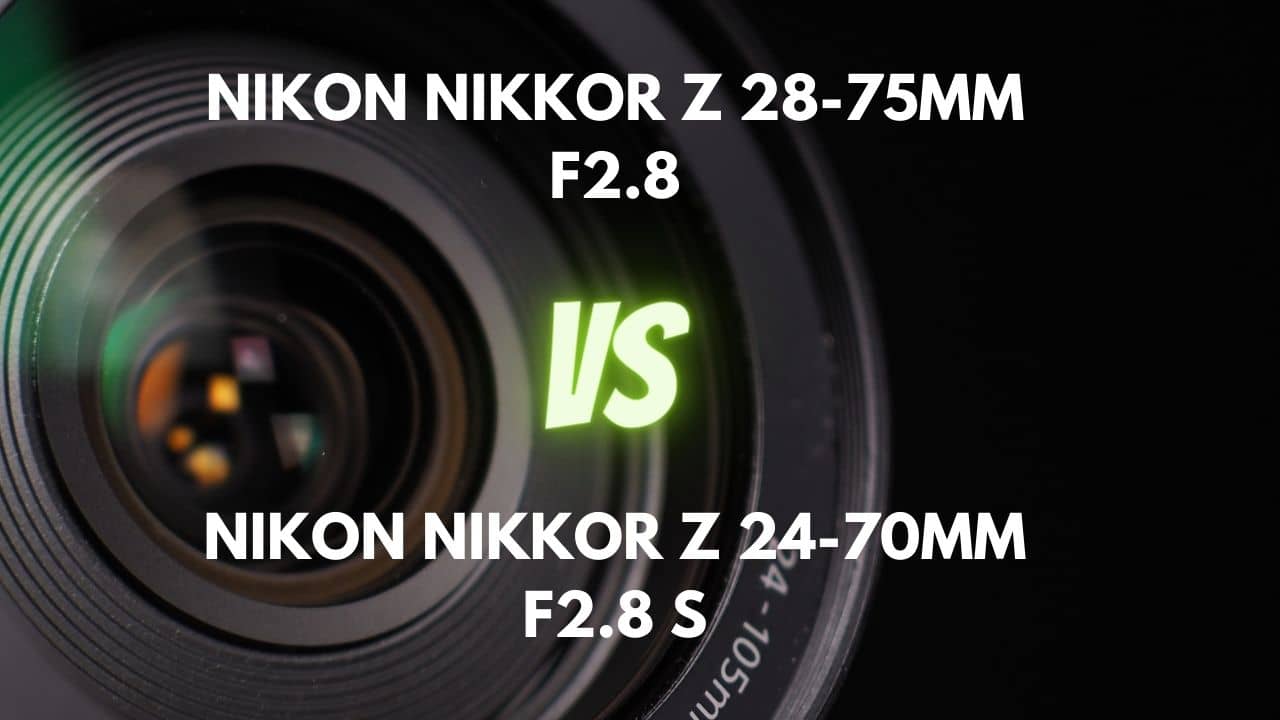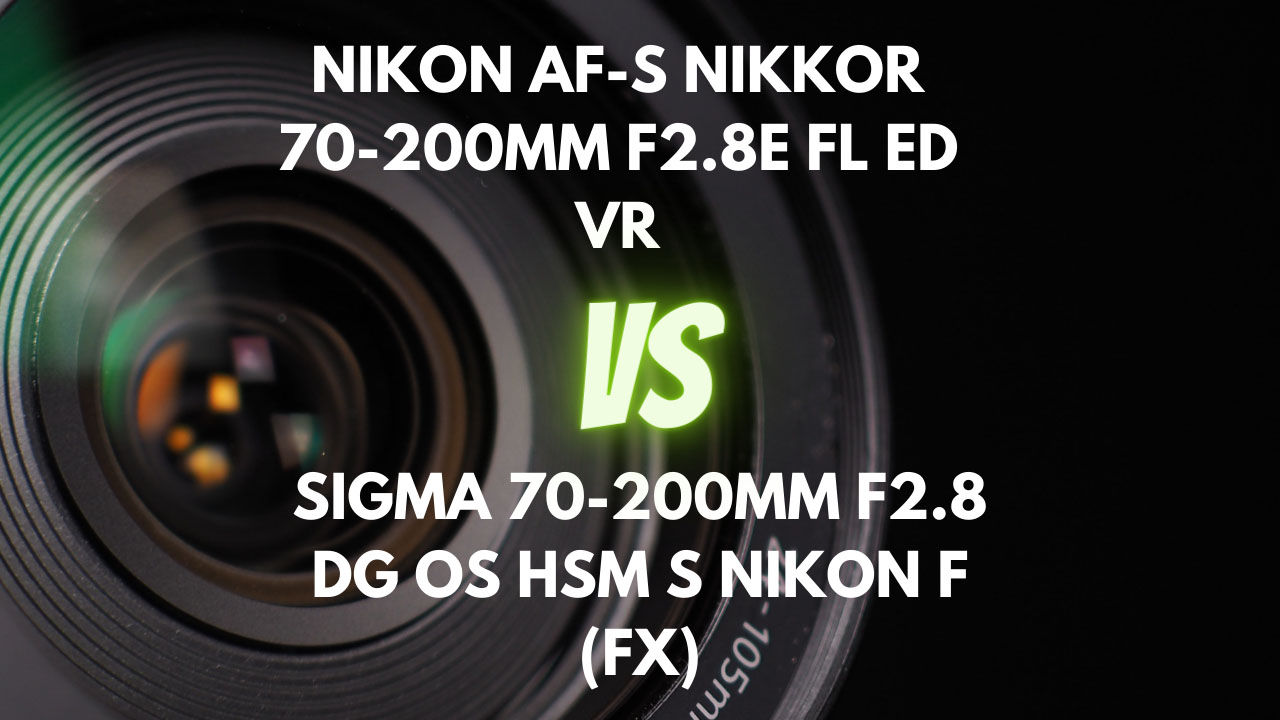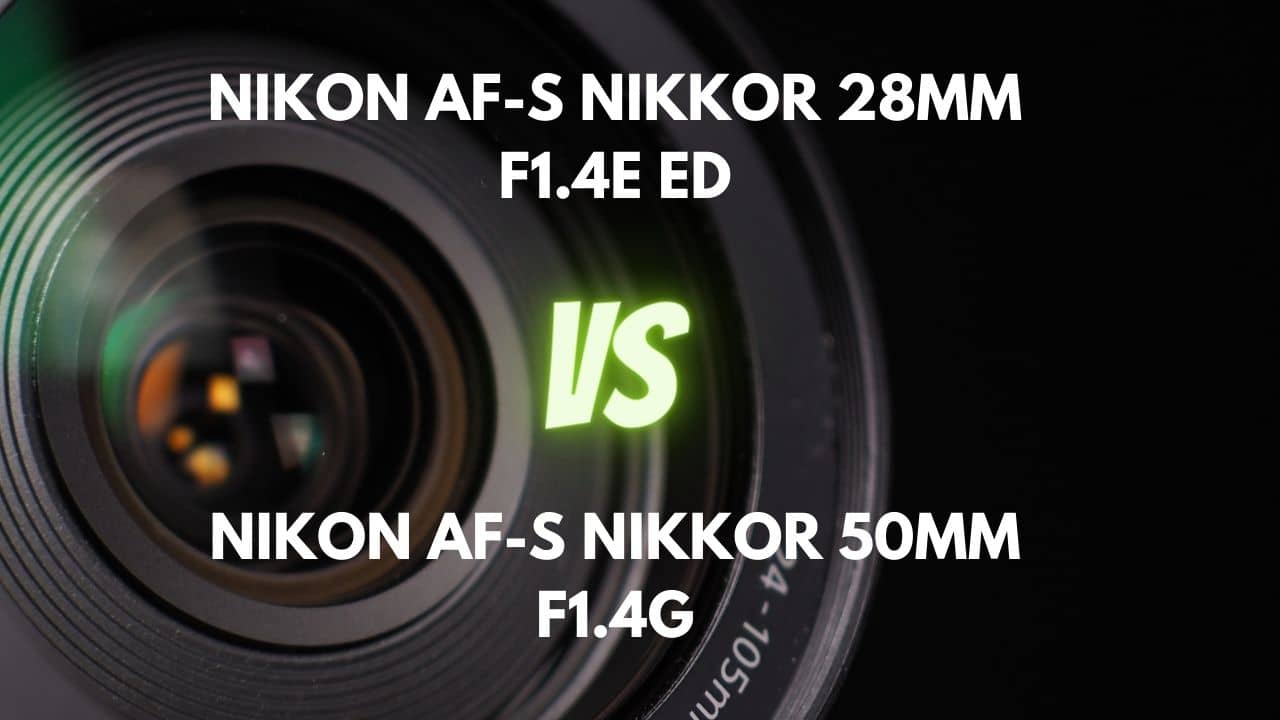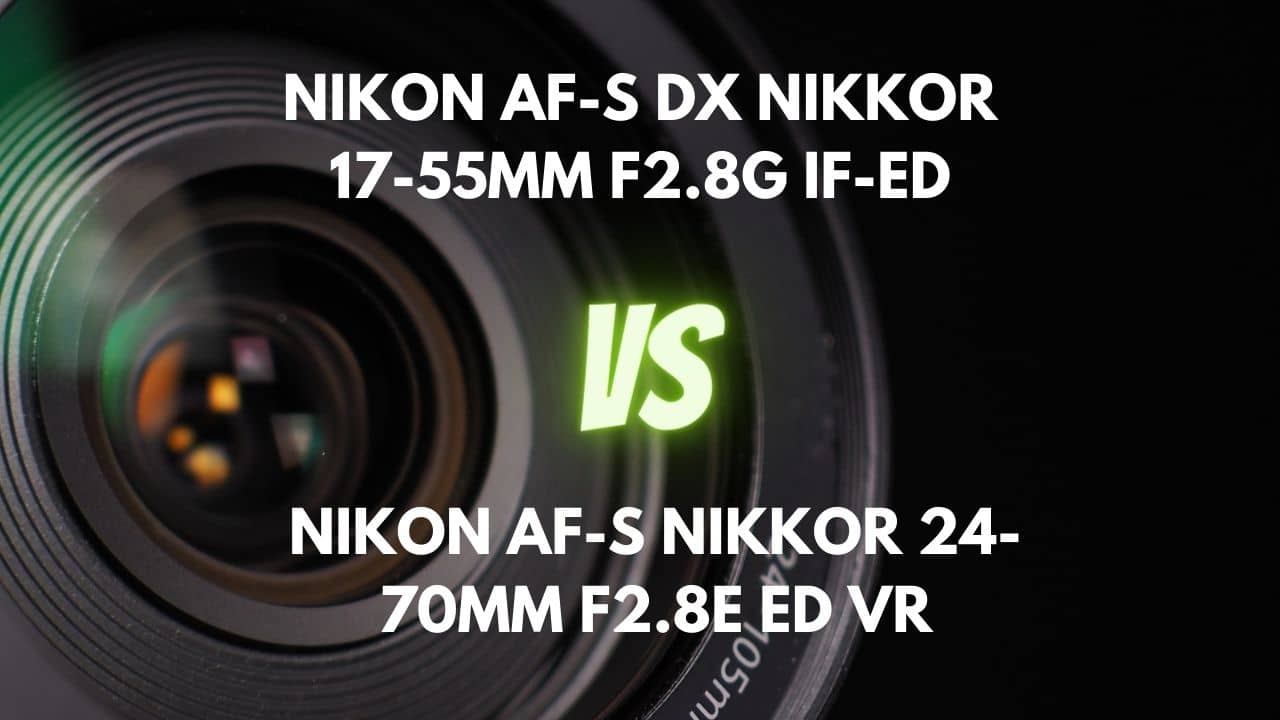As a photographer, the quest for the perfect lens is an exciting yet challenging endeavor, and finding the right balance between quality, versatility, and budget is paramount. That’s why today, we’re diving into an in-depth comparison of two popular contenders in the world of photography: the Nikon DX 17-55mm f/2.8 and the Sigma 17-50mm f/2.8. Both lenses boast fixed f/2.8 apertures, making them ideal for a wide array of photographic genres, including landscape, event, and travel photography, where low-light performance and depth of field control are crucial.
In this comprehensive article, we will explore the strengths and weaknesses of each lens, examining factors such as durability, weather sealing, ergonomics, focusing performance, sharpness, and more. Our comprehensive analysis can assist you in making a well-informed choice that meets your particular requirements and inclinations, regardless of whether you are an experienced expert or an aspiring enthusiast.
So, buckle up and join us on this exciting journey as we dissect the nuances of these two remarkable lenses, empowering you to make the best choice for capturing stunning images that will leave a lasting impression. Let’s unleash the full potential of your photography together!
Overview
| Nikon AF-S DX NIKKOR 17-55mm F2.8G IF-ED | Sigma 17-50mm F2.8 EX DC OS HSM Nikon F (DX) | |
|---|---|---|
| Max Aperture | F2.8 | F2.8 |
| Aperture Type | Fixed | Fixed |
| Focal Range (mm) | 17-55 | 17-50 |
| Mount Type | Nikon F (DX) | Nikon F (DX) |
| Zoom Ratio (X) | 3.2 | 2.9 |
The Nikon DX 17-55mm f/2.8 and Sigma 17-50mm f/2.8 both feature a fixed maximum aperture of f/2.8, providing consistent low light performance and depth of field control throughout their respective zoom ranges.
The Nikon 17-55mm has a slightly longer focal range (17-55mm) compared to the Sigma 17-50mm (17-50mm), and a slightly higher zoom ratio (3.2x vs. 2.9x). Both lenses are designed for Nikon F (DX) mount cameras.
Both lenses have similar low light performance, depth of field control due to their fixed f/2.8 aperture. However, the Nikon 17-55mm offers a bit more flexibility in terms of focal length and zoom ratio, potentially making it more versatile for various photography genres and situations.
Design and Ease of Use
| Nikon AF-S DX NIKKOR 17-55mm F2.8G IF-ED | Sigma 17-50mm F2.8 EX DC OS HSM Nikon F (DX) | |
|---|---|---|
| Diameter x Length (mm) | ⌀85.5×110.5mm | ⌀84×92mm |
| Weight (gr) | 755 | 565 |
| Filter Thread (mm) | 77 | 77 |
| Weather Sealing | Yes | No |
| Zoom Method | Rotary (internal) | Rotary (extending) |
| Distance Scale | Yes | Yes |
| DoF Scale | No | No |
| Hood Supplied | Yes | Yes |
The Nikon DX 17-55mm f/2.8 has a diameter of 85.5mm and a length of 110.5mm, while the Sigma 17-50mm lens is more compact with a diameter of 84mm and a length of 92mm. In terms of weight, the Nikon lens is heavier at 755 grams, compared to the Sigma lens, which weighs 565 grams. The Nikon lens features an internal rotary zoom method, while the Sigma lens uses an extending rotary zoom method.
The Sigma 17-50mm f/2.8 is more portable due to its smaller size and lighter weight, which can be advantageous for photographers who prioritize ease of carrying and handling. The Nikon 17-55mm lens, on the other hand, offers a more consistent balance while zooming and may have better weather sealing due to its internal rotary zoom design.
Lens Mount and Barrel
The Nikon DX 17-55mm f/2.8 features a dull-chromed brass lens mount with a rubber ring for weather sealing, ensuring protection from dust and water particles. The lens barrel is primarily made of metal, with some plastic parts and rubber-covered metal zoom and focus rings. The lens extends minimally at the extreme ends of the zoom range, but does not have an aperture ring or depth-of-field markings.
On the other hand, the Sigma 17-50mm f/2.8 has a metal lens mount that contributes to its overall build quality, but lacks weather sealing gaskets around the mount. Its lens barrel is made of plastic, coated with Sigma’s rubberized material for better grip. The barrel extends about 2.7cm when zooming to the longest focal length of 50mm, and a lock switch is provided to keep the lens retracted at 17mm to avoid zoom creep.
Comparing the two lenses, the Nikon 17-55mm lens offers a more durable and professional feel with its brass lens mount and weather sealing, as well as a mostly metal barrel. Conversely, the Sigma 17-50mm lens is more budget-friendly and portable with its plastic barrel and metal mount, although it sacrifices weather sealing.
Weather Sealing
The Nikon DX 17-55mm f/2.8 features a rubber ring at the lens mount, which helps to seal out dust and water particles, providing a certain degree of weather resistance. This enables photographers to capture shots in harsh weather conditions with some confidence. While the lens offers protection against the elements, it may not be fully weather-sealed like some other professional lenses on the market.
In contrast, the Sigma 17-50mm f/2.8 does not have weather sealing. There is no gasket at the lens mount, no internal seals at the rings and switches, and the front element lacks a fluorine coating. This makes it more vulnerable to dust, moisture, and light water splashes, which might limit its use in challenging environments.
Considering the additional knowledge provided, the Nikon 17-55mm lens is superior in terms of weather sealing compared to the Sigma 17-50mm lens. This added protection makes it a more suitable choice for photographers who frequently shoot in various weather conditions or outdoor environments. However, if you primarily shoot portraits indoors or in controlled settings, weather sealing may not be a top priority, and the Sigma 17-50mm lens could still be a viable option.
Rings
The Nikon DX 17-55mm f/2.8 features 2 rings: a focus ring and a zoom ring. The focus ring is wider than the zoom ring and is situated about halfway along the barrel, providing easy and precise control. The zoom ring, positioned closer to the camera, is thinner, which might be slightly challenging for those with larger hands.
Both rings offer a smooth, damped tactile experience and are easy to operate. The lens has a windowed distance scale but lacks a depth-of-field indicator. Overall, the Nikon 17-55mm lens has a well-designed ring layout, providing good control and ergonomic handling.
On the other hand, the Sigma 17-50mm f/2.8 also has 2 rings: a focus ring and a zoom ring. The focus ring, located towards the front of the lens, features raised rubber ribs but has a small focusing range of only 45 degrees, making manual focusing more tedious.
Additionally, the focus ring is not dampened and turns freely, which can be problematic during autofocus. The zoom ring is wider, has large raised rubber ribs, and features a zoom lock to fix the lens at 17mm. Both rings are smooth and exhibit no play. The lens has a focus distance scale printed on the manual focus ring but lacks a windowed distance scale and depth-of-field indicator.
Comparing the two lenses, the Nikon 17-55mm lens has a superior ring design due to its well-balanced layout, smooth operation, and better ergonomics. The Sigma 17-50mm lens, while still functional, has a few shortcomings in its focus ring and distance scale design that make it less ideal for precise control and adjustments.
Switches/Buttons
The Nikon DX 17-55mm f/2.8 features a single slider switch located on the left side of the barrel, which selects between M/A (autofocus with manual override) and M (manual only) focusing. This streamlined approach offers a simple and easy-to-use control for adjusting the focus mode during shooting. However, it lacks additional controls for other features.
On the other hand, the Sigma 17-50mm f/2.8 is equipped with two switches: one for image stabilization and one for autofocus/manual focus. These switches are noticeably raised from the lens barrel and are situated close to the lens mount. Their prominent design makes them easy to locate and use without causing discomfort during shooting, providing more accessible control options for various features.
Comparing the two lenses, the Sigma 17-50mm lens has a superior switches/buttons design due to the inclusion of both image stabilization and autofocus/manual focus controls. These easily accessible switches offer more functionality and convenience during shooting. The Nikon 17-55mm lens, although straightforward and user-friendly, is more limited in its control options, which might not be as suitable for photographers who desire more flexibility with their lens controls.
Filter Thread
The Nikon DX 17-55mm f/2.8 features a 77mm plastic filter thread that does not rotate when focusing, ensuring compatibility with polarizers and graduated filters. The plastic construction keeps the lens lightweight, but may be less durable than metal threads with frequent mounting and dismounting of filters.
In contrast, the Sigma 17-50mm f/2.8 also has a 77mm plastic filter thread at the front of the lens. This design holds large, vignette-free filters and offers a thread to attach the included lens hood. Like the Nikon lens, the front element of the Sigma lens does not rotate while focusing, making it easy to use with circular polarizers and ND grads.
Both the Nikon 17-55mm and Sigma 17-50mm lenses feature similar 77mm plastic filter threads, making them compatible with a wide range of filters and accessories. However, the Sigma 17-50mm lens has a slight edge due to its design that accommodates the included lens hood, offering additional protection and versatility for the lens.
Lens Hood
The Nikon DX 17-55mm f/2.8 comes with a plastic bayonet HB-31 hood with a deep petal shape that encloses the front element as it extends during zooming. The hood effectively shields the front element from extraneous light, reducing flare and maintaining image contrast.
The smooth plastic finish and ergonomic bevel make it comfortable to grip. While the hood can be smoothly rotated and clipped firmly onto the front of the barrel, it adds significant diameter to the lens and isn’t secure when mounted in reverse for storage or carrying.
On the other hand, the Sigma 17-50mm f/2.8 includes a petal-shaped, bayonet-fit lens hood in the package. Made of plastic, the exterior is smooth, while the interior features deep ribbing to minimize stray light. Some users note that the hood can spin off easily, but an adjustment tab helps secure it in place. The hood adds around 1.5 inches to the overall length of the lens and can be reversed for storage.
Both the Nikon 17-55mm and Sigma 17-50mm lenses come with petal-shaped, bayonet-fit lens hoods. The Nikon lens hood offers better flare protection but is less secure when mounted in reverse for storage. The Sigma lens hood has a ribbed interior, enhancing its light-blocking capabilities, and can be more securely stored when reversed. Taking these factors into account, the Sigma 17-50mm lens hood has a slight edge in terms of overall performance and convenience, making it the superior choice in this comparison.
Focusing and Optical Stabilization
| Nikon AF-S DX NIKKOR 17-55mm F2.8G IF-ED | Sigma 17-50mm F2.8 EX DC OS HSM Nikon F (DX) | |
|---|---|---|
| Autofocus | Yes | Yes |
| AF Motor | Silent Wave Motor | Hyper Sonic Motor |
| Rotating Front Element | Does not rotate on focusing | Does not rotate on focusing |
| Min Focus Distance | 0.36m | 0.28m |
| Max Magnification (X) | 0.2 | 0.2 |
| Full-Time Manual Focus | Yes | No |
| Focus Method | Internal | Internal |
Focusing Performance
The Nikon DX 17-55mm f/2.8 boasts fast and accurate autofocus performance, driven by Nikon’s Silent Wave Motor (SWM) technology. While its AF speed is average, autofocus accuracy is spot-on at every distance and focal length. The lens performs well in low-light situations, especially when using a focusing aid like an illuminator found on most flashguns.
The initial autofocus acquisition speed is good, and manual focus override allows for instant manual focus adjustments. With its smooth, well-damped focus ring, the Nikon 17-55mm features an internally focusing design, which means the lens length remains constant. Additionally, it does not exhibit focus breathing, making it ideal for cinematographers.
Conversely, the Sigma 17-50mm f/2.8 has decent autofocus performance, although it may not be as quiet as some users prefer. Its focusing speed is generally fast, taking about one second to focus from close to infinity. The lens performs well in low-light situations but may occasionally hunt for focus in very low light conditions. The initial autofocus acquisition speed is excellent, and the lens can focus accurately.
However, this lens lacks manual focus override, requiring a switch between autofocus and manual focus. The manual focus ring action is smooth, but its short throw makes precise adjustments more challenging. The lens features an externally focusing design, with no significant focus breathing, making it suitable for video work.
Both lenses offer good autofocus performance, but the Nikon 17-55mm has the advantage with its manual focus override, internally focusing design, and absence of focus breathing. These features make it more versatile and better suited for various photography scenarios, making the Nikon 17-55mm lens superior in terms of focusing performance.
Optical Stabilization
The Nikon DX 17-55mm f/2.8 does not feature optical stabilization, while the Sigma 17-50mm f/2.8 comes equipped with Sigma’s optical stabilization, rated at 4 stops of effectiveness. The stabilization offers excellent performance with silent, speedy, and precise compensation for camera movement.
Although it is slightly more effective than the Canon 17-55mm lens, it may not be as good as some of the more expensive lenses. With a single stabilization mode, the Sigma 17-50mm lens doesn’t make any noise during operation.
At 17mm, the lens delivers sharp handheld shots in low light with a net 3-stops of assistance from the optical stabilization at 1/4 sec exposures, and at 50mm, the shutter speed limit for sharp images is around 1/10 or 1/8 with a net 3-stops of assistance from optical stabilization.
Optical stabilization may not be as critical for wide-angle photography, but it can be beneficial in specific situations, such as shooting in low-light conditions handheld, at slower shutter speeds, or when recording video.
So, the Sigma 17-50mm lens is superior in terms of optical stabilization, as the Nikon 17-55mm lens does not offer this feature.
Image Quality
| Nikon AF-S DX NIKKOR 17-55mm F2.8G IF-ED | Sigma 17-50mm F2.8 EX DC OS HSM Nikon F (DX) | |
|---|---|---|
| Special Elements | 3x ED glass elements and 3x aspherical lens elements | 2 FLD glass elements 2 glass mold elements 1 hybrid aspherical lens |
| Diaphragm Blades | 9 | 7 |
| Circular Aperture | Yes | No |
Aberration
The Nikon DX 17-55mm f/2.8 exhibits chromatic aberration throughout the zoom range, with fringing up to 1.5 pixels wide towards the edges when stopped down beyond f/16, which may become noticeable in large prints with high contrast near the edges.
Coma performance is generally not an issue, as it is difficult to detect any significant sagittal coma flare. Spherical aberration is somewhat controlled, though not outstanding, with issues related to field curvature at 17mm and slightly lower border sharpness at 24mm @ f/2.8 and at 55mm.
On the other hand, the Sigma 17-50mm f/2.8 shows chromatic aberration, particularly at the 17mm focal length, where green and purple fringing is noticeable in the corners. Stopping down to f/4 results in improved sharpness and contrast, although chromatic aberration remains visible.
At 28mm and 50mm focal lengths, chromatic aberration is better controlled, and corner sharpness improves. This lens performs well for astrophotography in terms of coma, with stars appearing sharp across much of the field of view.
However, corners may display pronounced coma, chromatic aberration, and astigmatism. Spherical aberration doesn’t seem to be a significant issue for this lens. When shooting out-of-focus spots, axial aberrations are visible as purple halos around contrast areas, resulting in a loss of resolution, particularly when the lens is wide open. Despite these aberrations, the lens delivers near-perfect performance for a low-cost zoom, thanks to the high technology glasses used in its construction.
In conclusion, the Sigma 17-50mm lens offers superior control over aberrations, particularly at 28mm and 50mm focal lengths, and delivers near-perfect performance for a low-cost zoom. While the Nikon 17-55mm lens has some advantages in terms of coma and spherical aberration control, the overall aberration performance is better in the Sigma 17-50mm lens.
Sharpness
The Nikon DX 17-55mm f/2.8 delivers sharp images with outstanding sharpness in the center and good levels towards the edges of the frame. Peak clarity across the frame is achieved between f/5.6 and f/8 for most focal lengths, while at 55mm, peak quality across the frame is realized at f/5.6.
The lens is super sharp wide open to mid-aperture, with great color and contrast, and locks into focus quickly. Sharpness performance is top-notch at all apertures and everywhere in the DX image, and only slightly less contrasty in the far corners at f/2.8. The lens is sharp on DX, and there is little diffraction softness even at f/22.
In comparison, the Sigma 17-50mm f/2.8 exhibits good center sharpness throughout the zoom range, even at its wide open aperture of f/2.8. Corner sharpness, on the other hand, is less impressive when the aperture is wide open, particularly at 17mm.
However, stopping down the aperture to f/5.6 or f/8 improves corner sharpness significantly, with the sharpest point being at 50mm and f/8, where the entire frame appears almost tack-sharp. The lens may not be perfect in terms of sharpness, but it still delivers excellent performance for its price range, especially in the center.
In conclusion, the Nikon 17-55mm lens offers superior overall sharpness performance, with outstanding center sharpness and good edge sharpness across the frame. While the Sigma 17-50mm lens provides excellent center sharpness, it falls behind the Nikon 17-55mm in terms of corner sharpness. Therefore, the Nikon 17-55mm lens is the superior choice when it comes to sharpness.
Bokeh Quality
The Nikon DX 17-55mm f/2.8 offers reasonably good bokeh quality. While it may not be the best among its competitors, it delivers satisfactory results for most situations, particularly considering the lens design and its primary purposes. The bokeh is generally smooth and more pleasing towards the telephoto end of the zoom range. However, there might be some minor issues with highlight rendition at certain focal lengths and apertures.
In contrast, the Sigma 17-50mm f/2.8 produces a mixed bag of out-of-focus quality, with the 7-blade aperture struggling to maintain a circular shape beyond f/4, resulting in heptagon highlights. The aspherical elements create strong edges on bokeh lights resembling rolled condoms at close range distances.
Additionally, at the minimum focusing distance and maximum focal length, the bokeh blends with poor chromatic aberrations, making the effect look worse. However, in some cases, the bokeh can look nice, creating a pleasing background blur, but it’s not consistently smooth and beautiful throughout.
In conclusion, the Nikon 17-55mm lens provides superior bokeh quality when compared to the Sigma 17-50mm lens. Although neither lens is primarily designed for bokeh performance, the Nikon 17-55mm offers smoother and more pleasing results in various situations, making it the better choice for bokeh quality.
Flare/Ghosting
The Nikon DX 17-55mm f/2.8 is prone to flare in most backlight situations, and there may be some visible contrast degradation and ghosting when the light source is directly in the picture. However, the supplied lens hood does an excellent job of keeping light from hitting the front element in most situations, and the use of thin glass UV filters such as the Hoya Super Pro1 series can help reduce flare and UV rays. It’s important to adjust your shooting angle and use good filters to minimize flare.
On the other hand, the Sigma 17-50mm f/2.8 demonstrates impressive flare and ghosting control. In various test scenarios, such as shooting directly into the sun or capturing images with strong backlight, the lens performs remarkably well, with minimal flare or ghosting issues.
The presence of a lens hood further aids in reducing flares and unwanted reflections. This level of performance ensures that the captured images maintain their clarity and contrast even in challenging lighting conditions.
In conclusion, the Sigma 17-50mm lens outperforms the Nikon 17-55mm lens in terms of flare and ghosting control. The Sigma lens handles challenging lighting situations more effectively, maintaining image clarity and contrast, while the Nikon lens requires extra measures such as using filters and adjusting shooting angles to minimize flare.
Vignetting
The Nikon DX 17-55mm f/2.8 exhibits well-controlled vignetting characteristics. On digital bodies, light falloff is effectively managed throughout the focal range. Some users don’t mind vignetting and may even use it creatively to enhance their shots.
The Sigma 17-50mm f/2.8 controls vignetting quite well, with only slight corner shading at wide open apertures and noticeably less in the mid focal lengths. Stopping down to f/4 reduces corner shading to about 1 stop at 17mm. However, a normal thickness circular polarizer filter can add a small amount of mechanical vignetting at 17mm even at f/11. Larger aperture primes suffer more from vignetting than this zoom. Overall, the Sigma 17-50mm lens exhibits standard vignetting for its class, but with good control.
In conclusion, both lenses perform admirably in terms of vignetting control. The Nikon 17-55mm lens manages light falloff effectively throughout the focal range, while the Sigma 17-50mm lens has good control over vignetting, especially when stopping down the aperture.
Distortion
The Nikon DX 17-55mm f/2.8 exhibits some distortion at both ends of the zoom range, with barrel distortion at 17mm and pincushion distortion at 55mm. However, the distortion pattern is uniform across the frame, which makes it relatively easy to correct using image editing software.
The distortion is also low in amount and not as obvious as in some other Nikkor designs. While distortion may not be a big issue for some photographers, it would require correction for architecture photography.
The Sigma 17-50mm f/2.8 distortion varies depending on the focal length used. At 17mm, the lens has medium levels of barrel distortion, which decreases as the focal length increases. However, at the telephoto end (50mm), there is slight pincushion distortion that drops the lines to the frame center, visible mostly on the horizon.
Distortion is typical for a wide-angle zoom lens, and the Sigma 17-50mm has minimal distortion, especially in the middle sector of the zoom range, meeting the zero-distortion point at around 24mm. The lens is well-controlled, and any distortion can be fixed with Adobe Photoshop Lightroom if it’s an issue.
In conclusion, both lenses show some level of distortion at their respective focal length extremes. The Nikon 17-55mm lens exhibits a uniform distortion pattern that is relatively easy to correct, while the Sigma 17-50mm lens has minimal distortion, especially in the middle sector of the zoom range. However, both lenses offer distortion levels that can be corrected with image editing software if necessary.
Final Verdict
In conclusion, both the Nikon DX 17-55mm f/2.8 and Sigma 17-50mm f/2.8 have their respective strengths and weaknesses.
The Nikon 17-55mm lens offers more versatility in focal length, better weather sealing, superior ergonomics, focusing performance, sharpness, and bokeh quality.
On the other hand, the Sigma 17-50mm lens is more portable, budget-friendly, and performs better in controlling aberrations, flare, ghosting, and vignetting, as well as offering optical stabilization.
Ultimately, your choice between these two lenses will depend on your specific needs and priorities as a photographer. If you require a more durable, weather-sealed lens with better overall sharpness and focus performance, the Nikon 17-55mm would be the better choice.
However, if you are looking for a more portable and affordable lens with excellent control over aberrations, flare, ghosting, and vignetting, along with optical stabilization, the Sigma 17-50mm lens would be a suitable option.






